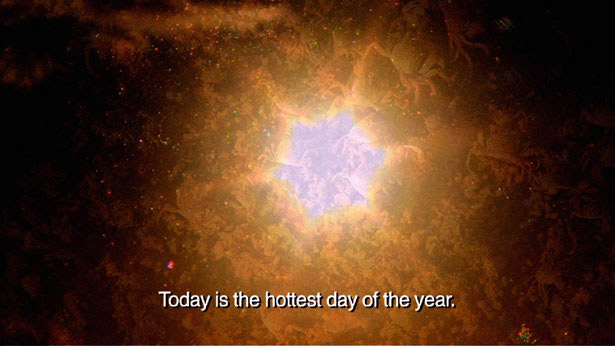7-10 October 2010
Hall 18, Booth 105
Berlin, Germany
Keren Cytter’s video The Hottest Day of the Year refers to the tradition of the romantic anthropological documentary. The artist was inspired by Chris Marker’s monumental film Sans Soleil (1983) and the works by the Vietnamese theoretician and filmmaker Trinh T. Minh-ha (*1952). In their documentaries and travel-reports, both directors were concerned with colonialism. With an essayistic style, they intermingle real and fictional elements with philosophical and sociological comments. In their works, Marker as well as Minh-ha investigate the medium of film itself—a self-referential point of view Keren Cytter also often employs.
The first part of Keren Cytter’s “documentary” tells the story of the imaginary Anne-Marie Baptist, born 1917 in France. A male narrator—the grand-child of the main character, as we learn later on—recounts: During the Second World War, Anne-Marie escaped Paris and traveled to South Africa to work as a nurse. While on a search for a mythical place where the two (really existing) African tribes Khoikhoi and San had fought each other, Anne-Marie Baptist contracted Malaria and died in the year 1950. The male voice is sporadically exchanged with a female French-speaking narrator reciting from Anne-Marie’s fictional travel journal. Cytter also displays old black and white photographs or links the invented story to real historical dates, thus providing the “documentary” with an atmosphere of authenticity.
After approximately 10 minutes, the second part of the film begins. Only now Cytter blends in the title of the video and the production company. A female soldier is supposed to be enlisted in an office of the Israel Defence Force. Tal Hefter’s background music changes into a locally well-known song about Israel’s landscape. The waiting soldier pages through a National Geographic Magazine; this can be understood as a linkage to the first part of the video. While one of the women suffers from a horrible migraine on this hottest day of the year, the second female soldier proceeds with the enlisting process of the aspirant. When asked for her profile—meaning an estimation of the physicality of the soldier between 21 and 97—the aspirant answers “82″, the year of the Lebanon war. Contrary to the laymen acting in the African part of the film, two trained actors and one director play the female soldiers. All of them are actually too old to be in the army.
The viewer is confused by the second part of the film, more so because it begins with the fade-in of the title in the middle of the video. This chapter is connected to the first one per association. The mythical location Anne-Marie Baptist searched for in Africa was cursed a long time ago: at this place, all actions are to lose their meaning. This is Cytter’s justification for telling a completely different story at the end of the video.
With The Hottest Day of the Year the artist proves once again her great talent for narration as well as for cinematic refinement. By means of emphatic dialogs and monologs, Keren Cytter—who is not only the author of her own screen-plays but also of several novels—really does carry the viewer off into another world.
*Image above:
5 of 5 + 2AP.
